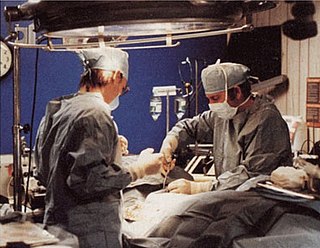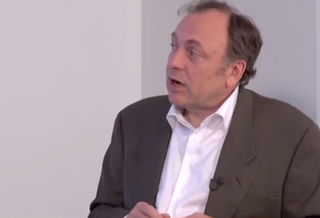Related Research Articles

Cryonics is the low-temperature freezing and storage of human remains, with the speculative hope that resurrection may be possible in the future. Cryonics is regarded with skepticism within the mainstream scientific community. It is generally viewed as a pseudoscience, and its practice has been characterized as quackery.

In physics, cryogenics is the production and behaviour of materials at very low temperatures.
Cryobiology is the branch of biology that studies the effects of low temperatures on living things within Earth's cryosphere or in science. The word cryobiology is derived from the Greek words κρῧος [kryos], "cold", βίος [bios], "life", and λόγος [logos], "word". In practice, cryobiology is the study of biological material or systems at temperatures below normal. Materials or systems studied may include proteins, cells, tissues, organs, or whole organisms. Temperatures may range from moderately hypothermic conditions to cryogenic temperatures.
The Alcor Life Extension Foundation, most often referred to as Alcor, is an American nonprofit, federally tax-exempt, 501(c)(3) organization based in Scottsdale, Arizona, United States. Alcor advocates for, researches, and performs cryonics, the freezing of human corpses and brains in liquid nitrogen after legal death, with hopes of resurrecting and restoring them to full health if the technology to do so becomes available in the future. Cryonics is regarded with skepticism within the scientific community and has been characterized as quackery and pseudoscience.

Robert Chester Wilson Ettinger was an American academic, known as "the father of cryonics" because of the impact of his 1962 book The Prospect of Immortality.
The Immortalist Society is a charitable 501(c)(3) organization devoted to research and education in the areas of cryonics and life extension. It was incorporated as a Michigan corporation by Robert Ettinger and five other local residents on June 27, 1967, as the Cryonics Society of Michigan, Inc.. In September 1976, the name of the corporation was changed to Cryonics Association in acknowledgement that its scope of operations was not limited to a single state. On October 20, 1985, the Articles of Incorporation were amended once more to change the name to Immortalist Society.

Michael D. West is an American biogerontologist, and a pioneer in stem cells, cellular aging and telomerase. He is the founder and CEO of AgeX Therapeutics, a startup focused on the field of experimental gerontology.
James Hiram Bedford was an American psychology professor at the University of California who wrote several books on occupational counseling. He is the first person whose body was cryopreserved after legal death, and remains preserved at the Alcor Life Extension Foundation.
Michael G. Darwin, formerly known as Michael Federowicz, is a former president of cryonics organization Alcor Life Extension Foundation. He was president from 1983 to 1988, and research director until 1992. He was also the founder and president of BioPreservation, Inc., and a cofounder, member of the board of directors, and director of research at Twenty-First Century Medicine from 1993 to 1999.
Jerry Donnell Leaf was Vice President and Director of the cryonics organization Alcor Life Extension Foundation, and President of the cryonics service firm Cryovita, Inc. until his death in 1991.
Curtis Henderson was a pioneer in the practice of cryonics.
Frederick Rockwell Chamberlain III and Linda Chamberlain founded the cryonics organization Alcor Life Extension Foundation. Their long and continued history of activism in cryonics make them among the most well-known cryonics pioneers. David Pascal wrote in the November/December 2005 issue of the Mensa Bulletin that, second to the man credited with the original idea for cryonics, Robert Ettinger, the Chamberlains have contributed more than anyone to the field of cryonics.
KrioRus is the first cryonics company in Russia. It was founded in 2005 by the Russian Transhumanist Movement NGO. It is the only cryonic company in Europe to possess an own cryonic storage. The company offers the services of freezing the entire bodies or heads of clients in liquid nitrogen with a plan to revive them if such a technology is developed, but takes no legal obligations to do so.
Dora Kent was the subject of a 1988 legal controversy about whether she had been murdered to facilitate her cryonic suspension. She was Alcor's eighth patient and the oldest at that time to ever be cryopreserved. She was the mother of Saul Kent, a board member of Alcor. In her earlier years, Kent worked as a dressmaker in New York City.

Cryopreservation or cryoconservation is a process where biological material - cells, tissues, or organs - are frozen to preserve the material for an extended period of time. At low temperatures any cell metabolism which might cause damage to the biological material in question is effectively stopped. Cryopreservation is an effective way to transport biological samples over long distances, store samples for prolonged periods of time, and create a bank of samples for users. Molecules, referred to as cryoprotective agents (CPAs), are added to reduce the osmotic shock and physical stresses cells undergo in the freezing process. Some cryoprotective agents used in research are inspired by plants and animals in nature that have unique cold tolerance to survive harsh winters, including: trees, wood frogs, and tardigrades.The first human corpse to be frozen with the hope of future resurrection was James Bedford's, a few hours after his cancer-caused death in 1967.[15] Bedford's is the only cryonics corpse frozen before 1974 still frozen today.
The Life Extension Society (LES) with its network of coordinators was the first cryonics organization in the world. It was founded by Evan Cooper in 1964 to promote cryonic suspension of people, and became the seed tree for cryonics societies throughout the US where local cryonics advocates would meet as a result of contact through the LES mailing list. The original LES ceased existence near the end of the 1960s, but an organization with the same name and similar objectives was incorporated in Maryland in 1992.
Suspended Animation, Inc (SA) is an American cryonics company founded in 2002 in Boynton Beach, FL. SA's purpose is to preserve bodies immediately after legal death to minimize the damages that occur before the body is cryogenically preserved. SA does not actually perform final cryopreservation, rather, they work with companies such as the Alcor Life Extension Foundation and Cryonics Institute which carry out the cryopreservations. Unlike Alcor Life Extension Foundation and Cryonics Institute, Suspended Animation, Inc does not offer memberships, but rather gains revenue from performing the one-time procedure.
Suspended animation in fiction refers to the temporary cessation of life processes experienced by fictional characters, followed by their subsequent revival. This process is commonly employed as a plot device in science fiction narratives. It is frequently utilized to transport a character from the past to the future or to facilitate interstellar space travel, which necessitates an extended journey for months or years. In addition to accomplishing the character's primary objective in the future, they often encounter the unfamiliarity of a new world, which may bear only faint resemblance to their previous surroundings. On occasion, a character is portrayed as possessing skills or abilities that have become lost to society during their period of suspension, enabling them to assume a heroic role in their new temporal setting.
William “Bill” Faloon is an author, life extensionist, and co-founder of the Life Extension Foundation, the Church of Perpetual Life, and the FDA Holocaust Museum.
The Shandong Yinfeng Life Science Research Institute, is a life science research institute and a cryonics services provider in Jinan, Shandong, China. It was founded in 2015, and it is a division of Yinfeng Biological Group. The institute is the first organization providing cryonics services in China. In 2017, the institute made the first cryopreserved patient in China. The institute cryopreserves cells, tissues, human bodies, and animals, including dogs. The institute cooperates closely with the Shandong Yinfeng Life Science Foundation that funds the institute.
References
- ↑ Swank, Edgar (October 2010). "The top 13 reasons to join ACS" . Retrieved February 11, 2011.
- ↑ Guynn, Jessica (2002). "Techies go for ice-cold afterlife". Contra Costa Times . Retrieved August 26, 2009.
- 1 2 Mondragon, Carlos (1994). "Defining the Cryonics Institution". Cryonics and Life Extension Conference. Alcor Life Extension Foundation. Retrieved August 23, 2009.
- 1 2 Best, Ben (2008). "A History of Cryonics". The Immortalist. Cryonics Institute.[ self-published source? ]
- 1 2 Best, Ben (2008). "Revival Assets Seminar" (PDF). The Immortalist. Cryonics Institute. Archived from the original (PDF) on November 23, 2008. Retrieved August 26, 2009.